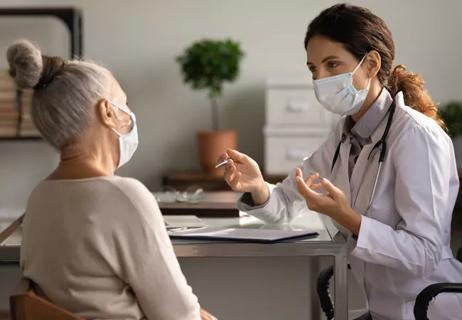Personalized care offered at the Pelvic Pain Center

Treating chronic pelvic pain (CPP) is tough. “There are multiple systems in the pelvic region that can cause pain, and pelvic pain itself has a variety of etiologies. That makes CPP challenging to diagnose and treat,” says M. Jean Uy-Kroh, MD, Director of the Chronic Pelvic Pain Program in the Women’s Health Institute at Cleveland Clinic. “It’s frustrating for the patient and physician when pain issues aren’t resolved.”
Cleveland Clinic is a non-profit academic medical center. Advertising on our site helps support our mission. We do not endorse non-Cleveland Clinic products or services. Policy
Cleveland Clinic officially opened its multidisciplinary Pelvic Pain Center to offer holistic care for patients with CPP in the fall of 2014. Prior to that, physicians here treated patients with CPP. But now the center is housed in one location on the fifth floor of the W.O. Walker Center on main campus. Since opening the Pelvic Pain Center, healthcare providers from approximately 10 specialties at Cleveland Clinic have collaborated on care for nearly 300 patients.
“Everyone’s journey with chronic pain is different,” says Dr. Uy-Kroh. “We take a lot of time to understand the patient’s history, personalize our care and speak with a unified voice about the best approach going forward.”
CPP is defined as noncyclical pain lasting more than six months that interferes with a patient’s quality of life and may cause functional disability. Approximately 70 to 80 percent of CPP cases involve women, though men can be affected too. There are many causes, including reproductive, urologic, gastrointestinal, vascular, neurologic, psychosexual and spinal issues. Often more than one cause is involved, and 30 to 50 percent of cases have no obvious pathology, making diagnosis and management challenging.
When patients are referred to Cleveland Clinic’s Pelvic Pain Center from internal or outside providers, Abigail Smith, CNP, reaches out to them. As coordinator of the Chronic Pelvic Pain Program, she explains the program’s services, sends a new patient assessment form and obtains all records from previous treatment providers. Next, Smith reviews all the documentation and coordinates appropriate physician visits, beginning with an intake appointment.
The Pelvic Pain Center is open on the third and fourth Tuesday of each month. The initial appointment, which takes at least one-and-a-half hours, begins with taking a detailed history. “The vast majority of our patients have seen multiple providers and come with a stack of records,” says Dr. Uy-Kroh. “It requires time to really understand what has and hasn’t worked for them in the past and what their goals are.” Next, the physician conducts a thorough physical exam. Depending on the patient’s unique situation, he or she may visit other specialists, such as urologists or gastroenterologists, the same day.
“When all of us meet the patient in one day, it not only saves the patient time and cuts expenses, but it helps in achieving the success and fruition of our treatments,” says Joseph Abdelmalak, MD, a member of Cleveland Clinic’s Department of Pain Management whose specialties include CPP. After these appointments, any providers involved in the patient’s care discuss the diagnosis and plan of care before sharing it with the patient.
Once a month, providers in the Pelvic Pain Center meet to discuss complex cases, communicating via email or phone as necessary between meetings. Depending on the case, the multidisciplinary meetings include caregivers from gynecology, colorectal surgery, urology, interventional radiology, pain management, physical therapy, neurology, urogynecology and/or gastroenterology. “You have six or seven doctors in the room, all in their chosen specialties, really trying to think about what else we can offer the patient. What hasn’t been tried, and what diagnoses are we not thinking of?” says Dr. Uy-Kroh. “A lot of collective experience goes into providing the best care.”
The results can be profound. Recently, Dr. Uy-Kroh had a conference call about a patient with three Cleveland Clinic physicians who are national thought-leaders in their respective fields. The patient desired surgery to treat her CPP, but the physicians were unsure if surgery was the best option. “We had honest discussions about our concerns if we went in direction A or B and what options are left for this patient,” says Dr. Uy-Kroh. After a half-hour conversation, experts in pain management and urogynecology agreed on the two to three other treatments to try before surgery.
“I am a surgeon, but the vast majority of patients we see in the Pelvic Pain Center are not surgical candidates,” says Dr. Uy-Kroh. “Overwhelmingly, they are medically managed.” Using a collaborative approach to care and taking time to understand each patient’s unique situation and to personalize care are the keys to treatment in the center.
“Each patient here is known by name,” says Dr. Abdelmalak. “Our patients deserve world-class healthcare, and their continued success is a top concern of our team.”
Many people live for months – even years – with CPP. But Smith says the length of time the patient suffers from chronic pain isn’t necessarily the deciding factor for physician referrals. Instead, it’s when a provider is looking for something else to offer the patient. “If they have tried things that haven’t worked or are they are looking for expert opinions from a multidisciplinary perspective, then they should refer patients to our Pelvic Pain Center,” advises Smith.
Another indication is when patients’ pain gets progressively worse or when they are relying heavily on narcotics. “We find a lot of patients on narcotics, and that’s not necessarily the answer,” says Dr. Uy-Kroh. “One of our biggest challenges is to alleviate patients’ anxiety over narcotics and help them find other ways to deal with their pain.” Just as the conditions related to CPP differ, so too do the treatments offered by the Pelvic Pain Center. They vary from conservative measures, such as lifestyle modifications and dietary changes, to nerve blocks or surgery.
“A lot of what we do is based on the patient’s functionality and quality of life,” says Dr. Uy-Kroh. “It’s not that we fix everyone’s pain. But we try to get them back to a place where they can lead the life they want to live.”

How we create obstacles for sexual, reproductive and menopausal healthcare despite our best intentions

One approved non-hormonal therapy and another on the horizon reduce vasomotor symptoms

Some post-menopausal patients may benefit from treatment

Study shows higher rates of complications, laparotomies among non-white women

Proper diagnosis and treatment require a careful mix of patient and clinical considerations

Study uniquely powered to compare adverse effects

What is female hypoactive sexual desire disorder and how is it treated?

Indications and best-practice recommendations for the use of androgen therapy